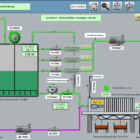Contactor
A contactor is an electromagnetically controlled switch that is used in control technology and automation to switch electrical loads such as pumps, motors, heaters or ventilators on and off. In water and wastewater technology, the contactor is a central component in switchgear systems, as it ensures reliable and fast control of the water flow.







